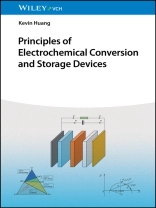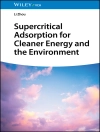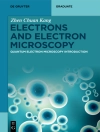Comprehensive resource covering fundamental principles of electrochemical energy conversion and storage technologies including fuel cells, batteries, and capacitors
Starting with the importance and background of electrochemical foundations, Principles of Electrochemical Conversion and Storage Devices explains the working principles and electrochemistry of electrochemical cells. After a summary of thermodynamic and kinetics, different types of fuel cells as well as batteries and capacitors are covered.
This book is written in the style of a textbook, providing illustrative examples and inspiring problems to facilitate the understanding of essential principles of electrochemical cells while offering practical insights for research pursuits. Various application examples are provided at the end of each chapter to strengthen reader understanding of energy storage from a practical point of view.
Written by a highly qualified and awarded academic and based on a culmination of his two decades of personal teaching and research experience in the field, Principles of Electrochemical Conversion and Storage Devices includes information on:
- Common reference electrodes and potentials, standard electrode potentials in aqueous solutions, and current functions for the charge transfer process
- Standard Gibbs free energy of formation of selected compounds, standard heat of combustion of common fuels, and commonly used physical constants
- Latest developments in the field, especially surrounding clean energy technologies, and various experimental methods essential for conducting rigorous electrochemical research
- Characterizing methods, key materials, and governing principles behind all of the covered devices
Providing comprehensive coverage of the subject, Principles of Electrochemical Conversion and Storage Devices is an excellent resource tailored for researchers and students from all technical and natural science disciplines seeking to understand more about the most promising energy-related devices and the potential they hold to change the world.
Tabella dei contenuti
Preface xi
1 Introduction 1
1.1 Brief History of Electrochemical Cells 2
1.2 Configuration of Electrochemical Cells 3
1.3 Half-Reactions in Electrochemical Cells 4
1.4 Faradaic and Non-Faradaic Reactions 5
1.5 Nernst Equation 6
1.6 Overpotential and Reaction Rate 7
1.7 Several Important Features of Electrochemical Cells 7
References 8
Problems 8
2 Thermodynamics of Electrochemical Cells 9
2.1 Open Electrochemical Cell Systems 9
2.1.1 Nernst Potential E n of Galvanic Cells 10
2.1.2 Thermoneutral Potential E tn of Electrolytic Cells 13
2.1.3 Thermodynamic Efficiency of Electrochemical Cells 15
2.2 Closed Electrochemical Cell Systems 16
2.2.1 E n of Batteries 16
2.2.2 Theoretical Energy Density of Battery Cells 17
2.2.3 Maximum Theoretical Charge Capacity of a Battery Cell 17
2.2.4 Round-Trip Efficiency of Battery Cell 18
2.3 Temperature Dependence of E n and E tn 18
2.4 Pressure Dependence of E n and E tn 20
2.5 Thermal and Chemical Expansion Coefficients 22
2.6 Heat Production and Consumption in Electrochemical Cells 23
2.7 Gibbs Phase Rule in Electrochemical Cells 25
References 27
Problems 28
3 Kinetics of Electrochemical Cells 29
3.1 Bulk Ionic Transport in Solid Inorganic Electrolytes (SIEs) 29
3.1.1 Ionic Conductivity 30
3.1.2 Extrinsic Ionic Conductors 31
3.1.3 Intrinsic Ionic Conductors 32
3.1.4 Random-Walk Theory 32
3.2 Ionic Transport in Solid Amorphous Electrolytes 34
3.3 Ionic Transport in Aqueous Solution Electrolytes 35
3.3.1 Basic Principles 35
3.3.2 Ideality versus Non-ideality 38
3.3.3 Walden’s Law 40
3.4 Comparison of Aqueous and Non-Aqueous Electrolytes 41
3.5 Kinetics of Electrode Reactions 41
3.5.1 Generic Rate of Electrode Kinetics 41
3.5.2 Potential-Dependent Rate of Electrode Kinetics 42
3.5.2.1 Standard Rate Constant k o 42
3.5.2.2 Exchange Current Density I O 43
3.5.2.3 Butler–Volmer Formulation 43
3.5.2.4 Mass Transfer Involved Activation Polarization 44
References 45
Problems 45
4 Fuel Cells and Electrolytic Cells 47
4.1 Fuel Cells/Electrolytic Cells Basics 47
4.2 Voltage Losses in FCs and ECs 49
4.2.1 Ohmic Voltage Loss 49
4.2.2 Activation Polarization 50
4.2.3 Concentration Polarization 52
4.2.3.1 Air-Electrode 53
4.2.3.2 Fuel-Electrode 56
4.2.3.3 Effect of Pressure 58
4.2.3.4 Coupled Activation and Concentration Polarizations 58
4.3 Efficiencies of Fuel Cells and Electrolytic Cells 59
4.3.1 Efficiency of Fuel Cells 59
4.3.2 Efficiency of Electrolytic Cells 61
4.4 Fuel Cells with Acidic Electrolytes 61
4.4.1 Pafc 61
4.4.1.1 Electrode Reactions 62
4.4.1.2 Cell Components 62
4.4.2 Pemfc 62
4.4.2.1 Electrode Reactions 62
4.4.2.2 Cell Components 62
4.4.2.3 Water Management 63
4.4.3 Solid Acid Fuel Cells 64
4.4.3.1 Electrode Reactions 64
4.4.3.2 Cell Components 65
4.5 Fuel Cells with Alkaline Electrolytes 65
4.5.1 Liquid Alkaline FC 65
4.5.1.1 Electrode Reactions 65
4.5.1.2 Cell Components 65
4.5.2 Anion-Exchange Membrane (AEM) FC 66
4.6 Fuel Cells with Molten Carbonate Electrolytes 66
4.6.1 Electrode Reactions 67
4.6.2 Components 67
4.6.2.1 Electrolyte 67
4.6.2.2 Electrolyte Matrix 67
4.6.2.3 Cathode 68
4.6.2.4 Fuel-Electrode (Anode) 69
4.6.2.5 Interconnect 69
4.6.2.6 Impurity Effect 69
4.7 Fuel Cells with Solid Oxide Electrolytes 69
4.7.1 Electrode Reactions 70
4.7.2 Components 70
4.7.2.1 Oxide-Ion-Conducting Electrolytes 71
4.7.2.2 Proton-Ion-Conducting Electrolytes 74
4.7.2.3 Air-Electrodes 75
4.7.2.4 Fuel-Electrodes 77
4.7.2.5 Interconnects 78
4.8 Electrolytic Cells 80
4.8.1 Co-Electrolysis of CO 2 and H 2 Oto Syngas 80
4.8.2 Electrochemical CO 2 Reduction Reaction (CO 2 RR) to Liquid Chemicals 81
4.8.2.1 CO 2 to Methanol Conversion 83
4.8.2.2 CO 2 to Formic Acid Conversion 83
4.8.2.3 CO 2 to CO Conversion 84
4.8.2.4 CO 2 to Methane Conversion 84
4.8.2.5 CO 2 to Ethanol Conversion 85
4.8.2.6 CO 2 to Ethylene Conversion 85
References 86
Problems 87
5 Batteries 89
5.1 Battery Basics 89
5.1.1 Discharge Curve Shape and Gibbs Phase Rule 89
5.1.2 Maximum Voltage and Energy Density of a Battery in General 91
5.1.3 Maximum Voltage and Energy Density of a Binary Conversion-Type Battery 91
5.1.4 Maximum Voltage and Energy Density of a Ternary Conversion-Type Battery 93
5.1.5 C-rate 94
5.1.6 Electrochemical Stability Window of Electrolytes 95
5.2 Rechargeable Batteries with Aqueous Electrolytes 96
5.2.1 Aqueous Batteries with Acidic Electrolytes 96
5.2.1.1 Lead Acid Battery (LAB) 96
5.2.1.2 All Vanadium Redox Flow Battery 98
5.2.2 Batteries with Alkaline Electrolytes and Ni-Based Cathode 99
5.2.2.1 Ni Cathode Chemistry 100
5.2.2.2 “Memory” Effect of Ni-Cathode 101
5.2.2.3 Ni–Cd Battery 101
5.2.2.4 Ni–Zn Battery 102
5.2.2.5 Ni–Fe Battery 103
5.2.2.6 Ni-Metal Hydride (MH) Battery 103
5.2.2.7 Alkaline Metal–Air Batteries 104
5.2.2.8 Alkaline Redox Flow Batteries 105
5.2.3 Batteries with Neutral Aqueous Electrolytes 106
5.3 Rechargeable Batteries with Organic Electrolytes 107
5.3.1 Organic Electrolytes 108
5.3.2 The “Rocking-Chair” Battery Concept 109
5.3.3 Intercalation Chemistry 109
5.3.3.1 Intercalation/Insertion Reaction 110
5.3.3.2 What Determines the Potential of a Redox Couple? 111
5.3.3.3 Terminology for Describing Structures of Intercalatable/Insertable Compounds 111
5.3.4 Intercalatable/Insertable Electrodes 112
5.3.4.1 Cathodes 112
5.3.4.2 Anodes 113
5.3.5 Conversion Electrodes 114
5.3.5.1 Cathodes 115
5.3.5.2 Anodes 115
5.3.5.3 Beyond Li-ion Chemistry 116
5.4 Rechargeable Batteries with Solid Electrolytes 116
5.4.1 Batteries with Oxide-Based Li-ion Conductors 117
5.4.2 Batteries with Oxide-Based Na-Ion Conductors 118
5.4.3 Battery with Oxide-Based Oxide-Ion Conductor 120
5.4.3.1 Configuration and Working Principle 120
5.4.3.2 Chemistry 121
5.4.3.3 Performance Metrics of SOMARBs 122
5.4.3.4 Kinetic Considerations of SOMARBs 123
5.5 Primary Batteries 124
5.5.1 Batteries with Aqueous Alkaline Electrolytes 124
5.5.1.1 Zn-Mn O 2 124
5.5.1.2 Zn–Air 125
5.5.2 Batteries with Organic Electrolytes and Li-Metal Anode 126
5.5.2.1 Li-Mn O 2 Battery 126
5.5.2.2 Li–Fe S 2 Battery 126
5.5.2.3 Li–cf X Battery 127
5.5.2.4 Li–SO 2 Battery 128
5.5.2.5 Li-SOCl 2 129
5.5.2.6 Li–Ag V 2 O 5 129
References 129
Problems 130
6 Capacitors 131
6.1 Capacitor Basics 131
6.1.1 Capacitance 131
6.1.2 Dielectrics 132
6.1.3 Capacitors in Electrical Circuits 134
6.1.4 Capacitance from CV and GCD 135
6.1.5 Capacitors for Electrical Energy Storage 136
6.2 Parallel-Plate Capacitors (PPCs) 137
6.3 Electrochemical Double-layer Capacitors (EDLCs) 139
6.4 Electrochemical Pseudocapacitors (ECPCs) 140
6.4.1 A Brief History of ECPCs 141
6.4.2 ECPC Materials 141
6.4.3 Types of ECPCs 141
6.4.4 Electrochemical Signatures of ECPCs 142
References 143
Problems 143
7 Basic Electrochemical Methods 145
7.1 Controlled Potential Methods 145
7.1.1 Constant Potential 146
7.1.2 Potential Sweep 147
7.1.2.1 Reversible Systems 148
7.1.2.2 Totally Irreversible Systems 149
7.1.2.3 Quasi-Reversible Systems 150
7.1.2.4 Cyclic Voltammetry 150
7.2 Controlled Current Methods 150
7.2.1 Constant Current 151
7.2.1.1 Reversible Electrode Reactions with Multi-electron Transfer 152
7.2.1.2 Totally Irreversible Electrode Process 152
7.2.1.3 Quasi-reversible Electrode Process 153
7.2.2 Coulometric Titration 153
7.3 Current Transient Method 154
7.3.1 Galvanic Current Interruption 154
7.3.2 Galvanic Intermittent Titration (GITT) 155
7.4 Electrochemical Impedance Spectroscopy 157
7.4.1 EIS Theory 158
7.4.2 Experimental Setup 161
7.5 Electrical Conductivity 162
7.6 Electrical Conductivity Relaxation (ECR) Method 164
7.7 Ion Transport Number of Electrolyte 166
7.7.1 The Hittorf Method 166
7.7.2 The Moving Boundary Method 167
7.7.3 Concentration Cell Method 169
7.7.4 Quartz Crystal Microbalance (QCM) Method 169
7.7.5 Evans–Vincent–Bruce Method 170
References 172
Problems 172
Appendix A Common Reference Electrodes and Potentials 175
A.1 Calomel Electrodes 175
A.2 Silver/Silver Chloride Electrodes 176
A.3 Converting Potentials Between Reference Electrodes 177
Appendix B Standard Electrode Potentials in Aqueous Solutions 179
Appendix C Current Functions for Charge Transfer Process 189
Appendix D Standard Gibbs Free Energy of Formation of Selected Compounds 193
Reference 241
Appendix E Standard Heat of Combustion of Common Fuels 243
Appendix F Commonly Used Physical Constants 255
Nomenclature 257
Index 269
Circa l’autore
Professor Kevin Huang is a Smart State Endowed Chair and Director of the Solid Oxide Fuel Cell Center at University of South Carolina. He teaches Advanced Thermodynamics and Energy Storage to graduate students. He is the associate editor of Journal of Electrochemical Energy Conversion and Storage. He is the recipient of numerous awards, including the 2018 Breakthrough Leadership in Research Award and the 2017 Educational Foundation Award for Research in Science, Mathematics, and Engineering.












